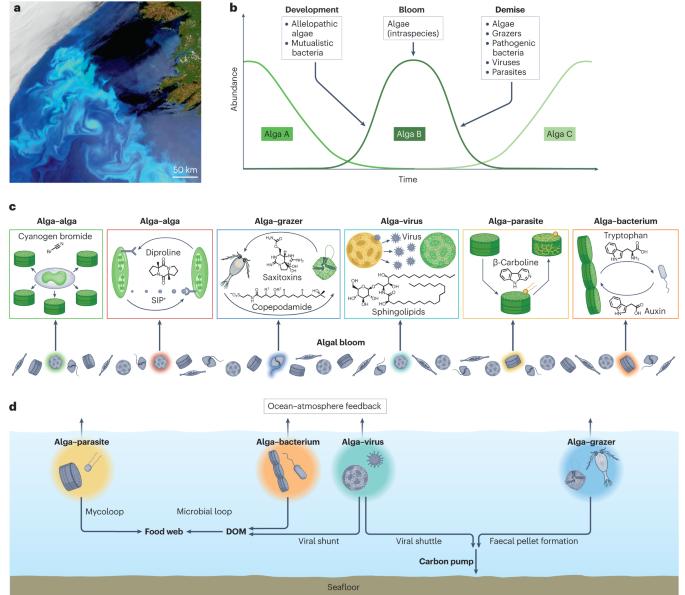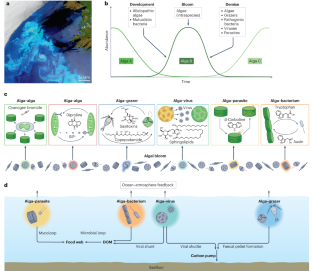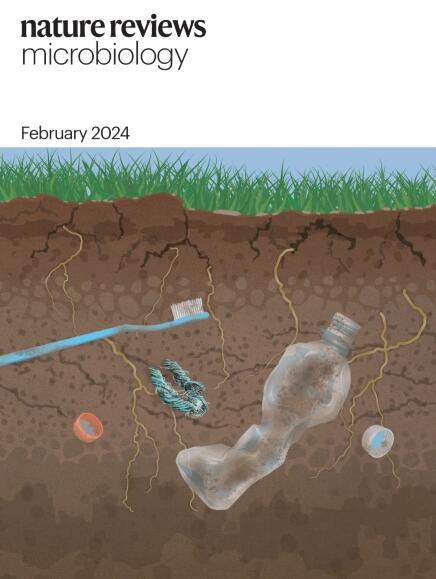海洋中的藻类水华:化学介导的微生物相互作用的热点。
IF 103.3
1区 生物学
Q1 MICROBIOLOGY
引用次数: 0
摘要
海洋中主要营养物质的循环受到大规模浮游植物水华的影响,浮游植物水华是微生物生命的热点。不同的微生物相互作用调节水华动力学。在单细胞水平上,微生物之间的相互作用是由化学串扰中的小分子介导的,化学串扰决定了相互作用的类型,从互惠性到致病性。藻类与病毒、细菌、寄生虫、食草动物和其他藻类相互作用,调节藻类细胞的命运,这些相互作用取决于环境环境。质谱和单细胞技术的最新进展导致发现了越来越多的信息化学物质——传递信息的代谢物——揭示了藻类细胞控制海洋中生物相互作用的能力。信息化学物质的多样性似乎解释了微生物通讯过程中细胞反应的特异性。鉴于藻华对生物地球化学循环和气候调节的巨大影响,一个主要挑战是阐明微尺度相互作用如何控制碳的命运和海洋中主要元素的回收。在这篇综述中,我们讨论了微生物的相互作用和信息化学物质在藻类水华中的作用。我们进一步探索了可能影响微生物相互作用的因素,以及在自然环境中破译它们的可用工具。本文章由计算机程序翻译,如有差异,请以英文原文为准。


Algal blooms in the ocean: hot spots for chemically mediated microbial interactions
The cycling of major nutrients in the ocean is affected by large-scale phytoplankton blooms, which are hot spots of microbial life. Diverse microbial interactions regulate bloom dynamics. At the single-cell level, interactions between microorganisms are mediated by small molecules in the chemical crosstalk that determines the type of interaction, ranging from mutualism to pathogenicity. Algae interact with viruses, bacteria, parasites, grazers and other algae to modulate algal cell fate, and these interactions are dependent on the environmental context. Recent advances in mass spectrometry and single-cell technologies have led to the discovery of a growing number of infochemicals — metabolites that convey information — revealing the ability of algal cells to govern biotic interactions in the ocean. The diversity of infochemicals seems to account for the specificity in cellular response during microbial communication. Given the immense impact of algal blooms on biogeochemical cycles and climate regulation, a major challenge is to elucidate how microscale interactions control the fate of carbon and the recycling of major elements in the ocean. In this Review, we discuss microbial interactions and the role of infochemicals in algal blooms. We further explore factors that can impact microbial interactions and the available tools to decipher them in the natural environment. In this Review, Vardi and colleagues examine the different microbial interactions that modulate algal blooms in the ocean, discuss the role of microbial chemicals in mediating such interactions and explore the latest technological developments aimed at deepening our understanding of cellular communication in the ocean.
求助全文
通过发布文献求助,成功后即可免费获取论文全文。
去求助
来源期刊

Nature Reviews Microbiology
生物-微生物学
CiteScore
74.00
自引率
0.50%
发文量
149
审稿时长
6-12 weeks
期刊介绍:
At Nature Reviews Microbiology, our goal is to become the leading source of reviews and commentaries for the scientific community we cater to. We are dedicated to publishing articles that are not only authoritative but also easily accessible, supplementing them with clear and concise figures, tables, and other visual aids. Our objective is to offer an unparalleled service to authors, referees, and readers, and we continuously strive to maximize the usefulness and impact of each article we publish. With a focus on Reviews, Perspectives, and Comments spanning the entire field of microbiology, our wide scope ensures that the work we feature reaches the widest possible audience.
 求助内容:
求助内容: 应助结果提醒方式:
应助结果提醒方式:


